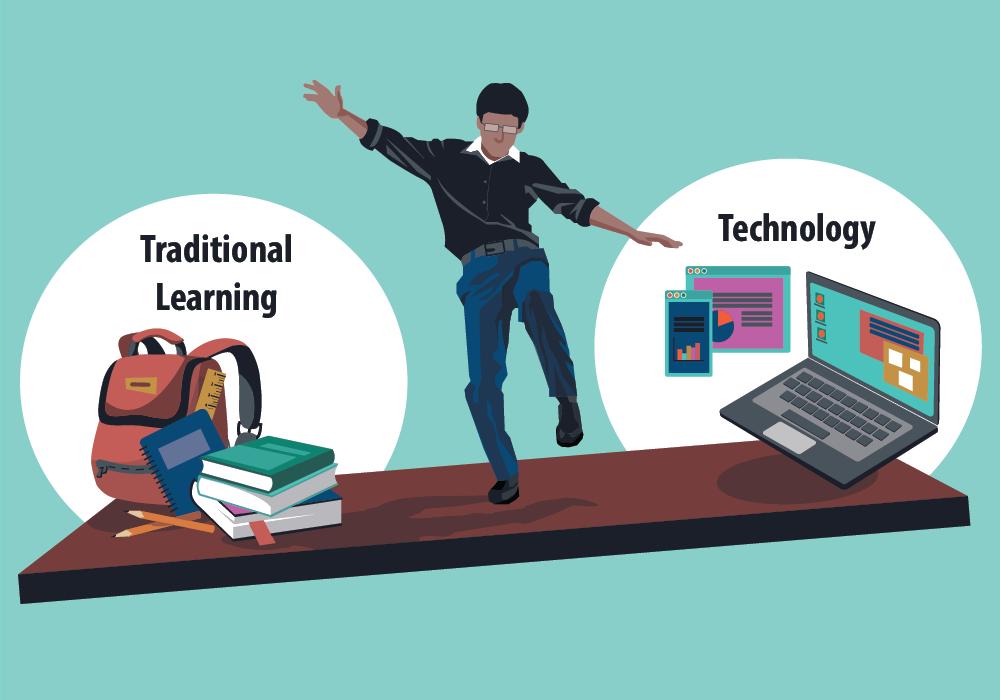Breaking Down Blended Learning
In part as a reaction to COVID, but also as a natural extension of the rise of technology, blended learning has shifted in recent years from a somewhat used teaching method to a learning model used by instructors nearly everywhere. But is it just another trend, or is it here to stay? All signs indicate that blended learning may eventually be the new norm for education.
But what is blended learning?

What Is Blended Learning
Blended learning—also known as hybrid learning—combines online educational materials with more traditional face-to-face teaching methods. This gives students the flexibility to customize their education in a way that makes the most of their learning potential and teachers the flexibility to instruct students in a way that supports those needs.
Advantages and Disadvantages of Blended Learning
Advantages of Blended Learning
• Additional Educational Tools: Blended learning allows instructors to add several new tools to their toolkits, from YouTube videos to online webinars, Ted Talks, and gamification tools—the possibilities are endless.
• Deeper Learning: Students are inherently capable learners. With the proper material, they can build the foundations of their education outside of class, which allows instructors to delve deeper into a subject with their students instead of only having time to cover the basics. Instructors can also provide activities for after class. These practices establish a three-layer learning process for any subject, improving retention.
• Meet the Needs of Diverse Learners: Blended learning borrows from nearly all methods of teaching: from audio learning to visual learning to hands-on learning. This makes it possible for instructors to reach students regardless of their learning styles.
• Promote Student Ownership: Students are, in many ways, in charge of their own learning. This means that what they put into their education, they get out of it. The application of this ownership is emphasized with blended learning, in which much of the learning happens on the student’s own time and is dependent on the student’s efforts.
• It’s Just Fun!
For more great advantages, check out our post, “Advantages of and Strategies for Blended Learning.”
Disadvantages of Blended Learning
• Pace of Advancement: While an advantage of blended learning, the ability for students to self-pace can also be a disadvantage. With the ability to watch lectures or participate in discussions at any time, it can become easy for students to lag behind the rest of the course or fail to engage with fundamental learning material.
• Time Consumption: While blended learning has many advantages for instructors and students alike, instructors may find the initial switch to blended learning time-consuming and difficult as they prepare lectures, find materials and resources, and develop a new curriculum.
• Material Overload: With so many resources out there that instructors can use to help their students learn, the sky is limitless. But so is the workload. Instructors may discover that while blended learning allows them to delve deeper into material with a variety of resources, students may be unable to keep up with the overload of material and may become overwhelmed by the number of resources available.
While these disadvantages are real, they are not insurmountable. There are many models that fall within the blended learning umbrella; this allows instructors to choose the model that will work best for their needs.
Blended Learning Models
Rotation Model
In the rotation model, students will often be split into groups and rotate through a variety of activities. This can include group work, personal projects, face-to-face instruction, and online activities. The key to the rotation model is structure. While it is often used entirely within the classroom, it can be done online with pre-recorded webinars, online discussion tools, and self-guided assignments.
Flipped Classroom Model
The flipped classroom model is approximately fifty-fifty online and in the classroom. Often, lectures are pre-recorded for students to listen to before class, while class time is used for activities and lessons that will dive deeper into the subject matter.
Enriched Virtual Model
The enriched virtual model is almost entirely online and self-guided. Most coursework and learning is completed virtually with opportunities for students to attend webinars with the instructor. In the end, though, with the enriched virtual model, it is the student who determines how much live or face-to-face interaction they will have with the instructor.
Flex Model
In the flex model, students take the lead in their learning. Students learn primarily online but are able to switch between synchronous and asynchronous learning. Instructors are present for support, guidance, and feedback on an as-needed basis.
Tips to Incorporate Blended Learning into Your Classroom
• Decide on a blended learning model. Different models have different levels of ‘blended,’ and choosing the right one for the situation is the first step. Will the course be mostly student-guided and flexible, or will the course be structured and use online resources at a minimum?
Keeping to one model throughout a semester will help to keep both students and instructors organized and prepared. Instructors should consider what level of blended works best for their unique teaching method.
• Set clear expectations. Students should understand which resources are available to them, what effort is expected of them, and how they can be successful.
• Tap into different tools. There are a variety of online resources that instructors can use. Use YouTube or other free video resources to find or create videos for your students to watch. Zoom and similar tools can be used to host live webinars. Online learning management systems, such as Blackboard or Canvas, can be used to keep students and instructors organized online.
• Include diverse activities. The possibilities are limitless. While there are standard options such as assessments, discussion boards, and essays, there are many more online options. Have students create YouTube videos or use online gamification tools; encourage students to create online portfolios or utilize interactive polls and quizzes. Online tools can be used to enhance activities from lectures to assignments and everything in between.
• Provide opportunities for collaboration. Just because students are online does not mean they do not need socialization with their peers. Learning to work well in groups is an essential skill students should learn to prepare to one day enter the workforce. Group work, conversation boards, and peer-review activities are all viable options, even when online.
• Prepare assessments. Assessments are just as essential, if not more so, in a blended learning environment. When students are learning at their own pace, instructors have less immediate feedback on how each student is learning. Assessments—quizzes, projects, essays, and more—are all fundamental in determining whether students are properly learning what they need to.
• Have fun! Blended learning allows for opportunities that were difficult or impossible to manage in the traditional classroom. Lean into these new possibilities!
For more great strategies, check out our post, “Advantages of and Strategies for Blended Learning.”
Blended Learning FAQs
How Effective Is Blended Learning?
Is it perfect? Of course not! But it does work. 73% of teachers say blended learning increases student engagement, while 60% of teachers believe blended learning improves academic ability. Why? Students often become bored by the pace of traditional learning—there’s that advantage of self-pacing coming into play; naturally, this results in lower engagement. Switching things up and allowing students to move at their own pace encourages them to be more engaged during the times that matter!
As technology continues to improve and grow, instructors will find themselves with more tools in their arsenals to help students learn. Hopefully, this will lead to blended learning becoming even more effective as a teaching model.
What Are the Best Models of Blended Learning?
The truth is that there is no one model that is “right” for every instructor. Blended learning’s greatest strength is the flexibility it provides instructors and students alike. Different models will work best in different situations. As an instructor, don’t be afraid to try different models to figure out which works best for you and your students.
How Can MyEducator Help with Blended Learning?
MyEducator learning resources are great assets for any blended learning model. With a text that can be used on any device, anywhere, at any time, students truly have control of when and where they can get their work done. But it’s not just for students: with LMS integration, instructors have more control, more easily. MyEducator also has customizable, auto-graded assessments, multi-media learning, advanced analytics, and more. To learn more, contact us!
References
“Blended Learning Defined and the Benefits of Using It: Learning A.” Z, June 30, 2022. https://www.learninga-z.com/site/company/what-we-do/blended-learning.
Pandurov, AuthorMarija, and Name *. “35 Exciting Blended Learning Statistics [the 2021 View].” Markinstyle, May 8, 2021. https://markinstyle.co.uk/blended-learning-statistics/.
Quigley, Eóghan. “What Is Blended Learning?” LearnUpon, August 17, 2022. https://www.learnupon.com/blog/what-is-blended-learning/.








